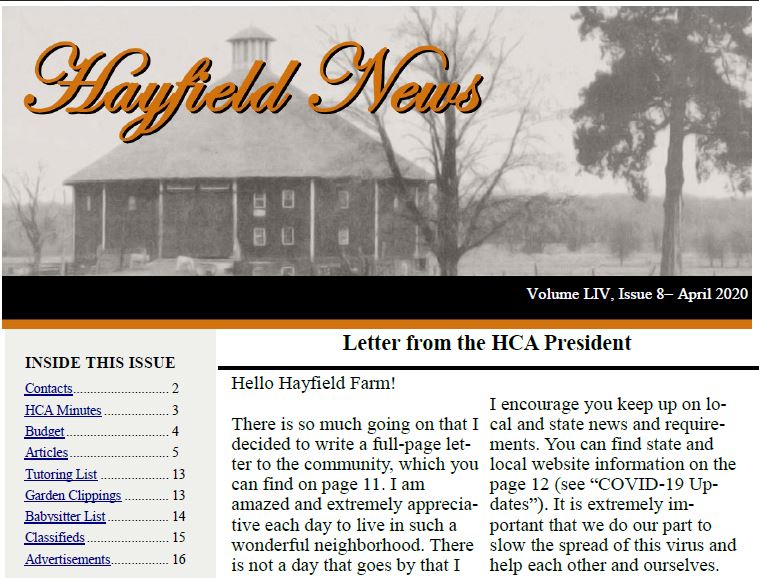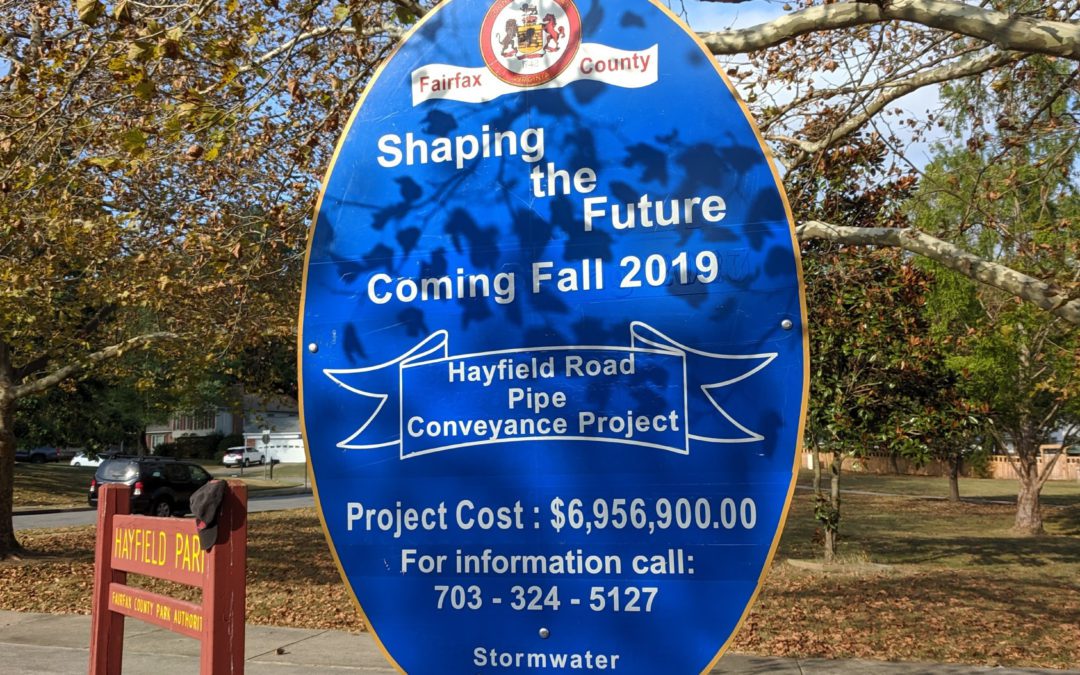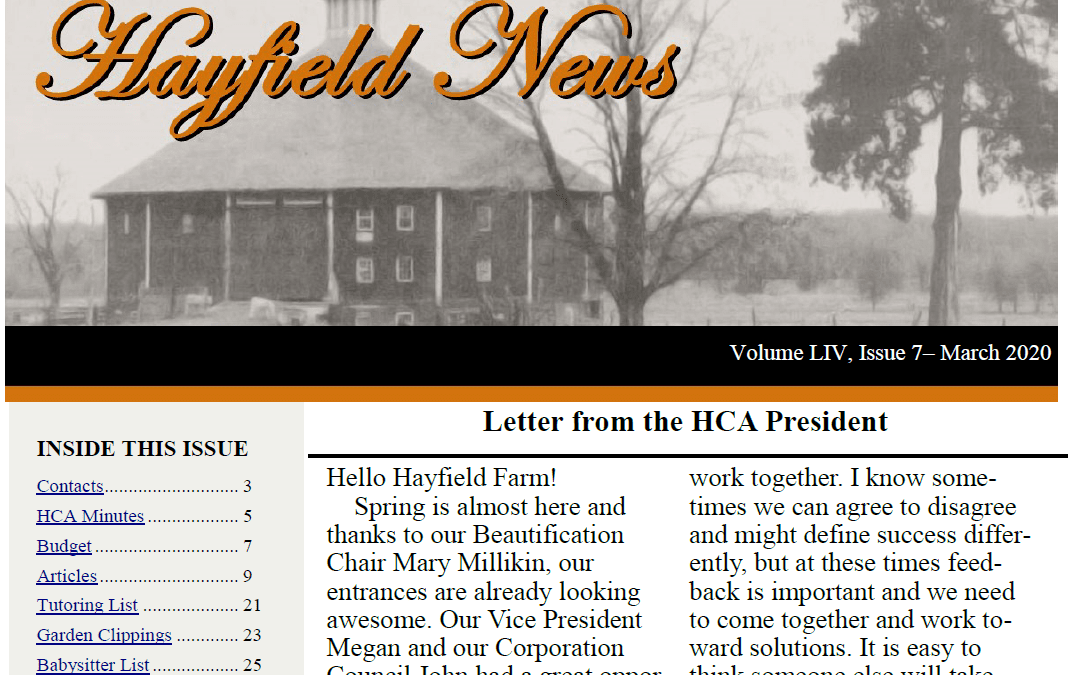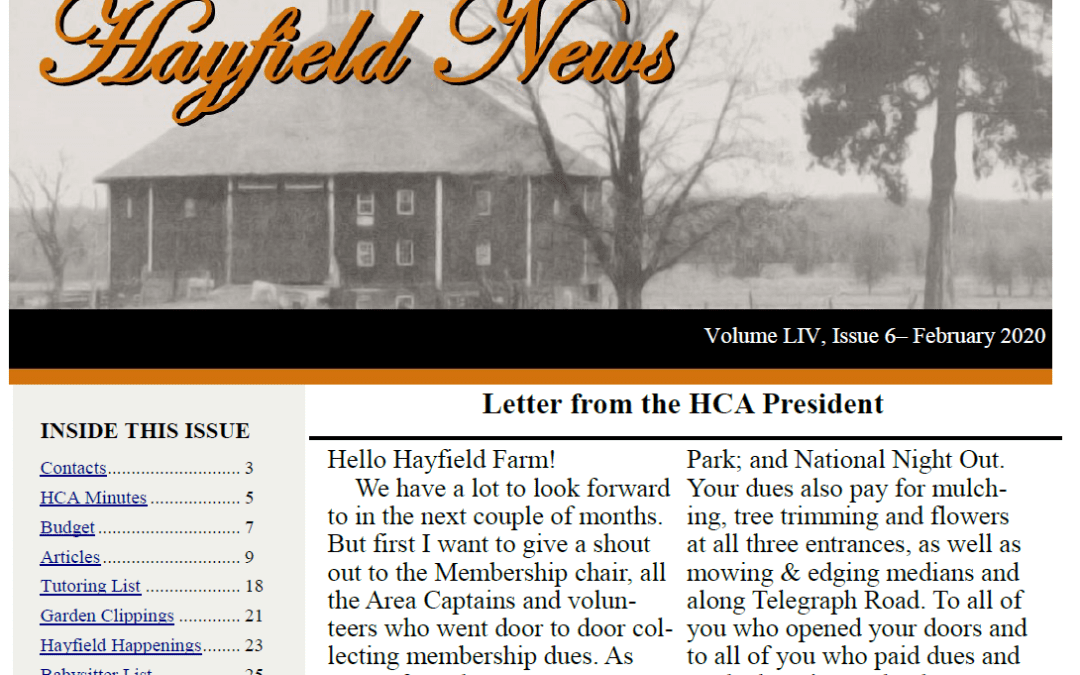Announcements

April Hayfield News 2020
Check out the April Hayfield News. Included in this issue: Hayfield Road Pipe Conveyance System Update, Hayfield Happenings, etc.

Hayfield Road Pipe Project: Tree Removed, Vibration Monitors, No Parking Signs
by John Millikin
Tree – The additional maple tree (as discussed in the February 2020 Hayfield News on page 13) was recently cut down as planned. It was originally scheduled to be removed by mid-February so there may have been some confusion because this did not happen until the end of March—but it is indeed the same tree. The article said the tree was “near 7721 Hayfield Road” but the houses actually closest are 7711 and 7712 Hayfield Road.
Monitors – On April 1, three vibration monitors were deployed/installed near this same area. Garney (the construction company) will be working near the monitors early next week, i.e., about April 6 or so. Project Manager Dave Anglin has asked them to surround the monitors with safety fencing to try protecting against anyone interfering with their operation. The monitors sensing mechanism can be disrupted by interference and provide false readings. So, it is important that everyone stay away from these vibration monitors. These are installed as close as possible to the structures within the public right-of-way (ROW). The VDOT maintained ROW extends approximately 2 feet on the house side of the sidewalk.
Please Obey “No Parking” Signs – Near the same area (where the tree was removed), on April 1 a car was parked in the single northbound travel lane blocking traffic and not honoring the No Parking signs. Drivers were forced to use the southbound lane. Vehicles parked in such a manner pose safety risks and logistical challenges and are likely to be towed going forward. Please do not park in the travel lanes during the times that your section of Hayfield Road is clearly marked via orange cones as two-lanes. Thank you all for your cooperation.

Hayfield Road Pipe Project: March Updates
by John Millikin
March 6 – Roadway from the Pool to Broadmoor St.
After Garney moves beyond the Broadmoor Street intersection work from the pool up to Broadmoor Street will include:
- Continue the box culvert installation approximately 250 to 300 linear feet where the system changes over to the 48” pipe.
- At about the same time as the system goes to being pipe, Garney will resume extending the sanitary main and lateral connections.
- Begin restoring curb & gutter, driveway aprons, and sections of sidewalk.
Remove temporary millings and pave the roadway with a base course of asphalt on the west side of the median.
Pavement condition on the east side of the grassed median will be monitored but the hope is not to have to do anything on that east section of roadway until project’s end. Still, Fairfax County will monitor conditions and undertake actions, if necessary.
March 17 – Status of Staging at the Pool Parking Lot
The May 1 date is Fairfax County’s commitment to vacate the pool parking lot irrespective on progress in the roadway. Storage for the box culvert sections was likely the most demanding of space. No additional box sections are required to complete that portion of the new conduit system. The 48” pipe installation is expected to move along a bit more quickly, in general. As discussed, weather is one factor. Though Garney intends not to use the space allocated to this project in Hayfield Park, that remains a possibility, if necessary / required. Here is a picture of the 48” pipe staged at the Hayfield Pool parking lot.
March 18 – Truck Deliveries and Safety at Work Site.
Four truck deliveries were scheduled with pipe sections via tractor trailer flat-bed trucks on March 20, 21, 23 and 24. The manufacturer’s transport company was not able to make all deliveries in one day as originally hoped. Dave Anglin reports that one of the topics that came up at a March 18 progress meeting centered on the presence of children in the neighborhood since schools are closed. Please remember that this project involves heavy construction and the work area should be avoided by everyone to the extent possible. Certainly, on-lookers from a distance are no problem. Parents, please closely supervise younger children and remind your teen-age children that they should always stay away from the construction zones.
March 26 – Schedule and Vibrations. The project has been running pretty close to being on schedule. Despite multiple efforts coordinating and verifying with Dominion Energy in 2018 and 2019, this week, we encountered an electrical conduit in conflict with the box culvert elevation. We are trying to push Dominion to address quickly. But, Garney will need to return to sanitary work or return to the end of the road to grade the outfall and install wing walls.
There was some survey work at Telegraph Road recently and Dave believes that is a Fairfax County Department of Transportation project, i.e., not related to the Pipe Project.
Recently I asked about vibration monitoring. Dave Anglin says that task order is approved and is being coordinated with Garney on their next steps and their proposed work area. As soon as we know that schedule, our geotechnical firm will deploy the monitors.
March 27 – Direct Contact Phone Number/Driveway Access; Potholes; Curbs.
The contractor (Garney) posts signs about parking; be sure to read them. Concerning driveway access, Garney is and has been extremely courteous and accommodating to all people affected in the work area. They knock on doors and ensure citizens’ access to their driveways when needed. Superintendent Eldon Burns can be contacted directly via his cell phone at 304-579-7177 if any Hayfield Farm resident has an issue in the immediate work area.
Potholes are a constant challenge; Garney should be fixing potholes the week of March 30 to April 3.
Keep in mind that there has been a separate water line relocation project around the corner on Broadmoor which may be getting confused with the Hayfield Road Pipe Project. This is a separate project and is not connected in any way with the Hayfield Road Pipe Project. The contractor is different and their workers are not Garney workers.
Contractors are installing new curbs along the west side of Hayfield Road from the Hayfield Pool up to Broadmoor Road. Here is one picture.
March 30 – Concrete Apron
Garney planned to remove and pour new concrete aprons for all driveways between Hayfield Swim Club and Broadmoor Street starting Wednesday 4/1/20 on Hayfield Road. Once concrete aprons are poured, the resident needs to try and stay off for at least 4 days, not to damage the concrete. Dave Anglin recommended that Garney talk with the residents and then barricade the apron for those four days, if possible.

March Hayfield News 2020
Check out the March Hayfield News. Included in this issue: Hayfield Road Pipe Conveyance System Update, Hayfield Happenings, etc.
HCA Proposed By-Laws
- Substantive #1. Elected Residents – Elected Officers must be current dues-paying members who live in Hayfield Farm.
- Substantive #2. Term Limits – The current term for the five elected officers should change to (a) Four consecutive years and (b) a maximum of 10 years as a Board of Directors member.
- Substantive #3. Not Tax Exempt – HCA is a 501(c)(4) organization, not a charitable organization; donations are not tax deductible.
- Substantive #4 Parliamentarian –The requirement for this position should be eliminated and two duties combined with the Corporation Counsel’s responsibilities.
- One page summary of proposed HCA By-Laws
- Proposed HCA By-Laws with Edits 2020 (16 pages; shows edits in yellow; yellow highlight will not print; see next file)
- Proposed HCA By-Laws with Edits for Printing 2020 (same as above, however edits show in gray–these will print)
- Proposed HCA By-Laws-
2020 (13 pages; just the proposed by-laws; yellow highlights and strikethroughs are included)

February Hayfield News 2020
Check out the February Hayfield News. Included in this issue: Hayfield Road Pipe Conveyance System Update, Hayfield Happenings, etc.

Recent Comments